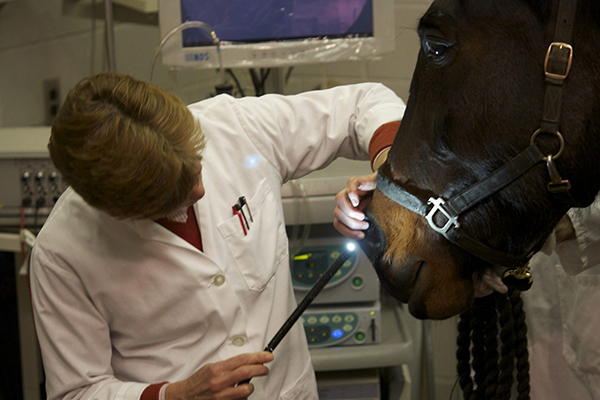OVC Researcher Contributes to Global Paper on Equine Asthma

Introducing an endoscope into the horse’s nose en route to the lungs.
By: Jackie Zions, Equine Guelph
Not long after the 2019 Havemeyer Workshop on Equine Asthma, Dr. Dorothee Bienzle, Ontario Veterinary College, contributed to a large collaborative research paper – The current understanding and future directions of Equine Asthma research.
The air was thick with ideas at the 2019 Havemeyer Workshop, with a broad group of approximately 50 participants made up of microbiologists, clinicians, pathologists and other researchers all exchanging ideas, and sharing information. “It was a wonderful opportunity to get together with people from all over the world who study equine asthma and respiratory disease,” says Bienzle. “We are so grateful to the Havemeyer Foundation and the organizer, Dr. Laurent Couetil, for making it all possible.”
The workshop provided a chance to share ideas on topics such as: what early onset versus late stage asthma looks like, and how it manifests in horses affected by pasture environments versus stable-associated asthma. There was discussion of fungal spore inhalation off the pasture grasses in asthma found in hot, humid climates in comparison to the asthma found in Northern climates where researchers are confident contributors to asthma are a combination of fungal spores, bacterial components and most likely dust.
Bienzle and her team concentrate on the host response to challenges like dusty barn air by looking at the epithelium in the lung. By the time a horse presents with severe equine asthma (= heaves) – they are looking at the disease close to the end stage. By taking biopsies of the epithelium in horses with heaves, they look at the genes and proteins that are present and expressed. Changes often include: airway remodeling, inflammation and fibrosis, to name a few. “The goal would be to identify the disease early during onset, which might allow the disease to be reversed,” says Bienzle.
Through next generation sequencing, Bienzle and her team have distinguished differences in gene expression between asthmatic and non-asthmatic horses. They have looked at signature variants that may indicate a susceptibility to asthma. They have identified a lack of certain anti-inflammatory proteins such as CCSP. A lack of repair functions has been observed in horses with end stage equine asthma such as a reduced ability to produce cytokines in adequate numbers and the inability to recruit undifferentiated epithelial cells to repair epithelial damage.
Unfortunately, at this time there are no early predictors of equine asthma. It may be possible that bouts of inflammatory airway disease at a younger age could predispose horses to asthma in later years but as of yet such evidence is not available. Bienzle explains the need to follow a large group of horses over their lifespan to come up with better predictors.
Be sure to watch the accompanying video which includes images from an endoscope procedure used prior to a bronchoalveolar lavage (lung wash). Through use of an endoscope, one can assess the mucosa in the trachea and bronchi for secretions, blood, purulent material and look for other indicators impacting respiratory health. Narrowing of airway indicates a reduced ability to pass air in and out of lung. Excess mucous secretions are a secondary sign that reflects inflammation.
Take-aways for horse owners dealing with heaves include: early diagnostics, aggressive treatment and, most importantly, environmental management. Intervention is recommended at the first sign of a cough, especially if the cough is repetitive or persistent. Bronchoalveolar lavage (BAL) is the gold standard diagnostic test for asthma. Corticosteroids administered with a bronchodilator may be prescribed to help the horse recover from bouts of equine asthma but environmental improvement is the key. The best advice is to get them out of dusty barns and into fresh air.
Until the advent of early diagnostics, the focus for equine asthma needs to be first on prevention, and second on management and environmental improvement.
Bio: Dr. Dorothee Bienzle, Research interests and select publications
Professor | DVM Guelph, M.Sc. Guelph; PhD McMaster, Diplomate ACVP
YouTube Video Link: https://youtu.be/zZtkGCvRhd8
Research Paper: https://www.ncbi.nlm.nih.gov/pmc/articles/PMC7438831/
About Havemeyer Foundation:
http://www.havemeyerfoundation.org/aboutfoundation.htm
This story first was published as the cover story of Equine Guelph’s Annual Research Update – Volume 18 Jan, 2021. Read the entire publication.










